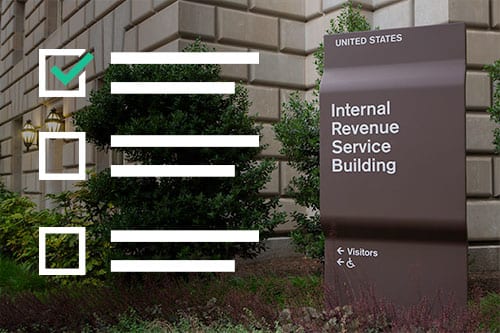The IRS Top 10 Checklist for a New Business
Starting a new business, especially if it is your first entrepreneurial endeavor, involves a great many decisions and detailed planning if you want to assure success. The planning for production, marketing, and accounting for your profits can be fun, and it is easy to let the far more boring taxation planning wait. At the very least, let the IRS Publication 583i give you a checklist for getting on track. It gives you the highlights and links you to more detail. At the very least, you can use this checklist to meet with an accountant or tax professional to put your plan into action.
- What new business owners need to know – In this first checklist item, the IRS just refers you to a partner agency, the SBA, Small Business Administration, to hit these bullet points for your new business:
- What are my financial resources?
- What products and services will I sell?
- How will I market my products and services?
- How will I develop a strategic business plan?
- How will I manage my business on a day-to-day basis?
- How will I recruit employees?
- Determine the type of business formation to use – Here you get a brief introduction to the types of business structure: sole proprietorship, partnership, limited liability company (LLC), S-Corporation, and corporation. You are linked out to resources with more detail to determine which structure is best for your new business. This should probably be an important part of your discussion with your tax professional.
- Getting your taxpayer identification number – To submit your business tax returns or report your income and expenses, you will need a taxpayer identification number. The two types of number usually make this a simple decision at the beginning:
- An SSN is issued to individuals by the Social Security Administration (SSA) and is in the following format: 000–00–0000.
- An EIN is issued to individuals (sole proprietors), partnerships, corporations, and other entities by the IRS and is in the following format: 00–0000000.
- Designating a tax year – Depending on your business products, services, or seasonality, you have choices as to what you designate as your tax year for reporting. Though most business owners use the Calendar Year, from January 1st to December 31st as their tax year, you have two other choices. You can choose a tax year that is 12 consecutive months and ends on the last day of a month (except December). In other words, your tax year could be from April 1st through March 31st. You also have a choice of a 52–53-week tax year which varies between 52 and 53 weeks and does not have to end on the last day of a month. There are some more details in this section, as well as limits on changing tax year later.
- Choosing your accounting method – You have the choice of two methods of accounting. Using the cash method, you report income in the year you receive it and expenses in the year they are paid. If you have an inventory involved in your business, you usually must use the accrual method of accounting. In this method you report income in the year in which it is earned, even if you have not yet received payment. You also report expenses in the year they are incurred, even if you have not yet paid them.
- What taxes will you be required to pay – In this item you learn the types of taxes businesses pay as different from personal taxes. They include:
- Income tax.
- Self-employment tax.
- Employment taxes.
- Excise taxes
- What are information returns – Information Returns are common for partnerships and other pass-through business entities that pass their profits through to owners to be reported on their personal returns. The information return reports to the IRS the income of the business as passed through, and that information is matched with the owners’ personal returns to make sure taxes are paid on all income.
- Avoid these penalties – Go to this section to get the details, but to simplify it for you; if you do anything wrong, late, or not as per IRS rules, you are most likely to be penalized in various ways. Go to the section for the painful details.
- Deducting your allowable business expenses – In this section you get an overview of the major business expense categories including home office, depreciation, start-up costs, as well as normal operating expenses of the business.
- Recordkeeping – In this item, you get an overview of what the IRS considers important to keep for records and how to organize them for reporting with returns.
IRS Publication 583 is a great quick reference to provide talking points for discussions and planning with your tax professionals.
i IRS Publication 583, IRS.gov

